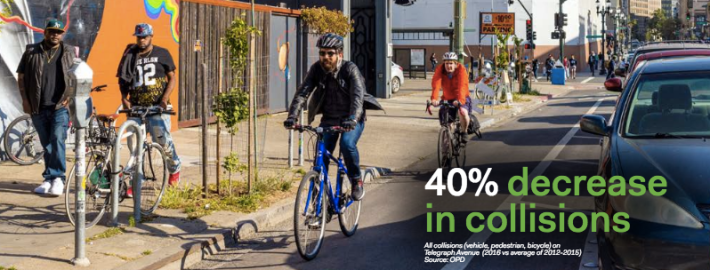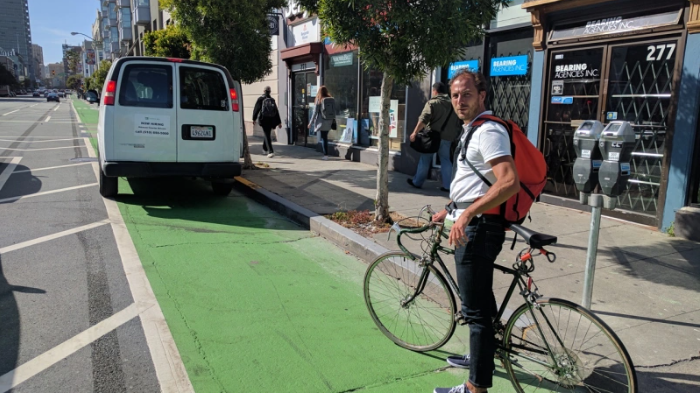Note: GJEL Accident Attorneys regularly sponsors coverage on Streetsblog San Francisco and Streetsblog California. Unless noted in the story, GJEL Accident Attorneys is not consulted for the content or editorial direction of the sponsored content.
At Tuesday's hearing of the Oakland City Council to decide whether to support significant safety upgrades on 14th Street, Councilmember Carroll Fife asked outgoing OakDOT Director Ryan Russo about quick-build strategies to get protected bike lanes on 14th Street and elsewhere as soon as possible.
Russo, as he did in his latest Q&A with Streetsblog, said his department didn't have the resources to do quick builds.

There's a lesson here as Oakland looks for Russo's replacement.
Yes, OakDOT's resources are stretched. But last year Russo tried to use some of those scarce resources to remove protected bike lanes in the KONO district on Telegraph Avenue. And, under his guidance, Oakland installed fresh paint and bollards for buffered--but unprotected--bike lanes on Telegraph between 29th and MacArthur streets. Oakland has even installed robustly protected bike lanes around construction zones using Jersey barriers, only to remove them later. Russo is also on the record saying that protected bike lanes aren't the "gold standard" and he told me after our Q&A had concluded that protected bike lanes aren't a "panacea."

Of course they aren't a panacea. But years of data from the Netherlands and elsewhere show that on busy city streets there's no other configuration that has a better record for encouraging cycling and preventing serious injuries and deaths (short of banning cars). This turns out to be true in Oakland as well.
This was underscored last Thursday when Dmitry Putilov was killed by a motorist near the intersection of 14th and Jefferson while riding in a freshly painted but unprotected bike lane.
It is not, and never was, a resource issue. And it's not about outreach, the other excuse given by Russo. We don't do years of outreach for curb ramps, hi-viz crosswalks, traffic lights, daylighting, or a dozen other well-understood measures that save lives. When a disproportionate number of people hurt and killed in bike vs. car collisions are Black, it's warped to insist on years of equity outreach before safer infrastructure can be installed.

It's obvious that Russo has a blind spot for data when it comes to protected bike lanes. To see that, all you need do is compare the amount of paving and street improvements that have gone in during Russo's tenure to the paltry few miles of protected bike lanes that have been added.
The bottom line is U.S. traffic planners are taught that maintaining automobile speed, throughput, and parking is more important than protecting cyclists and pedestrians. And too many in the profession still treat cyclists as if they're just slower motor vehicles instead of what they are: fragile, precious, and unprotected adults and children on wheels.
There will never be a bell loud enough, a helmet strong enough or clothing bright enough to make up for poor infrastructure. pic.twitter.com/zPTbQE1wbL
— Tom Flood (@tomflood1) June 16, 2022
The Dutch have long recognized that, except in the quietest residential areas, designing streets that put people next to two- to fifteen-ton cars and trucks is tantamount to criminal negligence. If there should be any difference between Dutch and Bay Area street designs, it would be that the Bay Area's protected lanes will need more robust concrete and iron barriers, given the popularity of large vehicles in the U.S. and the DMV's inability to get dangerous drivers off the roads.
Oakland officials need to keep all this in mind as they search for a replacement for Russo. It is imperative that they find someone who has long-term experience working in the field in the Netherlands, the country with the best record in the world on encouraging cycling and preventing injuries and deaths. They should consult with the Dutch Cycling Embassy, Modacity in Delft, and others in the Netherlands when conducting their search and when building new templates for Oakland street designs.

Put simply, Oakland needs to look to Holland, not Hayward, when hiring Russo's replacement.





